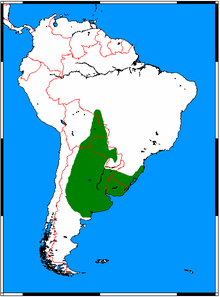Pampas fox
| Pampas fox | |
|---|---|
 |
|
| Scientific classification | |
| Kingdom: | Animalia |
| Phylum: | Chordata |
| Class: | Mammalia |
| Order: | Carnivora |
| Family: | Canidae |
| Genus: | Lycalopex |
| Species: | L. gymnocercus |
| Binomial name | |
|
Lycalopex gymnocercus (Fischer, 1814) |
|
 |
|
| Natural range shown in green | |
The pampas fox (Lycalopex gymnocercus), also known as grey pampean fox, aguará chaí, aguarachay, Azara's fox, or Azara's zorro, is a medium-sized zorro, or "false" fox, native to the South American pampas. The alternative common names are references to Spanish naturalist Félix de Azara.
The pampas fox resembles the culpeo or Andean fox in appearance and size, but has a proportionately wider snout, reddish fur on the head and neck, and a black mark on the muzzle. Its short, dense fur is grey over most of the body, with a black line running down the back and onto the tail, and pale, almost white, underparts. The ears are triangular, broad, and relatively large, and are reddish on the outer surface and white on the inner surface. The inner surfaces of the legs are similar in color to the underparts, while the outer surface is reddish on the fore limbs, and grey on the hind limbs; the lower hind limb also bears a distinctive black spot. Adults range from 51 to 80 cm (20 to 31 in) in body length, and weigh 2.4 to 8.0 kg (5.3 to 17.6 lb); males are about 10% heavier than females.
In the northern part of its range, the pampas fox is more richly colored than in the southern part.
The pampas fox can be found in northern and central Argentina, Uruguay, eastern Bolivia, Paraguay, and southern Brazil. It prefers open pampas habitats, often close to agricultural land, but can also be found in montane or chaco forest, dry scrubland, and wetland habitats. It is most common below 1,000 m (3,300 ft) elevation, but can inhabit puna grasslands up to 3,500 m (11,500 ft).
Five subspecies are currently recognised, although the geographic range of each is unclear, and the type localities of three of them lie outside the present-day range of the species:
Fossils of this species are known from the late Pliocene to early of Argentina.
...
Wikipedia

